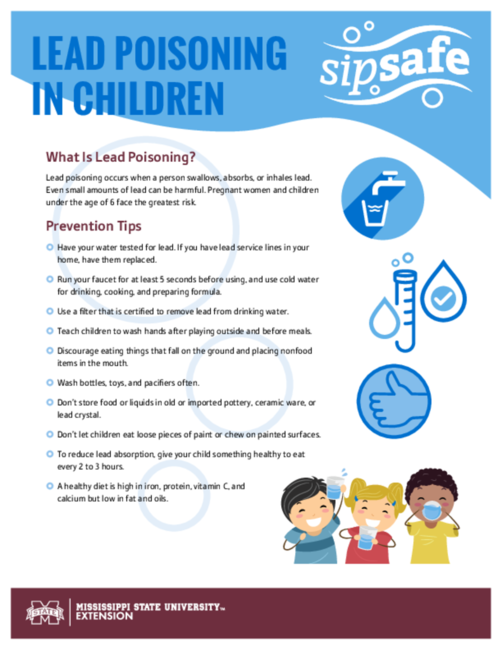P3572
Lead Poisoning in Children
What Is Lead Poisoning?
Lead poisoning occurs when a person swallows, absorbs, or inhales lead. Even small amounts of lead can be harmful. Pregnant women and children under the age of 6 face the greatest risk.
Prevention Tips
- Have your water tested for lead. If you have lead service lines in your home, have them replaced.
- Run your faucet for at least 5 seconds before using, and use cold water for drinking, cooking, and preparing formula.
- Use a filter that is certified to remove lead from drinking water.
- Teach children to wash hands after playing outside and before meals.
- Discourage eating things that fall on the ground and placing nonfood items in the mouth.
- Wash bottles, toys, and pacifiers often.
- Don’t store food or liquids in old or imported pottery, ceramic ware, or lead crystal.
- Don’t let children eat loose pieces of paint or chew on painted surfaces.
- To reduce lead absorption, give your child something healthy to eat every 2 to 3 hours.
- A healthy diet is high in iron, protein, vitamin C, and calcium but low in fat and oils.
Lead Poisoning Signs and Symptoms
Most children do not have any obvious signs or abnormal symptoms. Signs of damage sometimes show later; therefore, it is important to have your child’s blood lead level tested by a medical professional, whether they show symptoms or not.
These are some signs and symptoms of lead poisoning:
- Irritability
- Frequent tiredness
- Behavioral problems
- Stunted growth
- Learning problems
- Hyperactivity
- Decreased appetite
- Developmental delay
- Hearing loss
- Does your child spend a lot of their time in a home
- built before 1978?
- with peeling or chipping paint?
- that has recent, ongoing, or planned remodeling?
- that has plastic mini-blinds purchased before 1997?
- Does your child frequently come in contact with an adult who works with lead?
- Have items other than vegetation been burned outside near the home?
- Does your child play with keys, electrical cords, or lead fishing sinkers?
- Have any siblings or playmates of your child had lead poisoning?
- Does your child consume water from a well?
- Does your child live or play near an airport or airfield regularly?
What Is a Healthy Home?
A Healthy Home is designed and maintained to support the health of its residents. Follow the seven Principles of a Healthy Home below to keep your family healthy and safe!
Keep It Dry
Check your plumbing, roof, and drainage system for leaks to avoid mold and mildew.
Keep It Clean
Remove dust and clutter to reduce allergens.
Keep It Ventilated
Supply fresh air to reduce chemicals in the home. Open windows or use exhaust fans while
bathing or cooking to reduce moisture.
Keep It Pest-Free
Seal cracks and openings to prevent insects and rodents from entering your home.
Keep It Safe
To prevent injuries, install items such as smoke and carbon monoxide detectors, fire extinguishers, cabinet locks, and electrical outlet covers.
Keep It Contaminant-Free
Reduce the exposure to lead, tobacco smoke, and other contaminants in your home.
Keep It Maintained
Inspect, clean, and repair your home routinely.
What Is Green Cleaning?
Green cleaning is a way to use safer products to reduce contaminants in your home. Try some of our green cleaning recipes:
Air Freshener
Place a few slices of a citrus fruit, cloves, or cinnamon in a pot with enough water to simmer gently for 1 to 2 hours.
Furniture Polish
Dissolve 1 teaspoon of lemon oil in 1 cup of vegetable oil. Apply with a clean, dry cloth.
Disinfectant
Mix ½ cup of borax in 1 gallon of hot water for cleaning.
Floor Cleaner with Fragrant Herbs
In a bucket, combine 1/8 cup of liquid soap or detergent, ¼ to ½ cup of white distilled vinegar or lemon juice, and ½ cup of fragrant herbal tea (peppermint adds antibacterial qualities). Swirl the water around until it is sudsy, and use the mixture to scrub the floor with a mop.
Before using any of these recipes, test them on an inconspicuous area.
For more tips and recipes on green cleaning, visit the Mississippi State Department of Health website.


For more information, please contact Jason R. Barrett at jason.barrett@msstate.edu or visit extension.msstate.edu.
Information in this publication was adapted from material developed by Mississippi State Department of Health.
This project is funded by the Water Infrastructure Improvements for the Nation Act 2107: Lead Testing in School and Child Care Program Drinking Water Grant.
Publication 3572 (01-24)
By Jason R. Barrett, PhD, Associate Extension Professor, Nelson A. McGough Jr., Research Technician, and Justin Palmer, Extension Associate, Water Resources Research Institute.
The Mississippi State University Extension Service is working to ensure all web content is accessible to all users. If you need assistance accessing any of our content, please email the webteam or call 662-325-2262.
